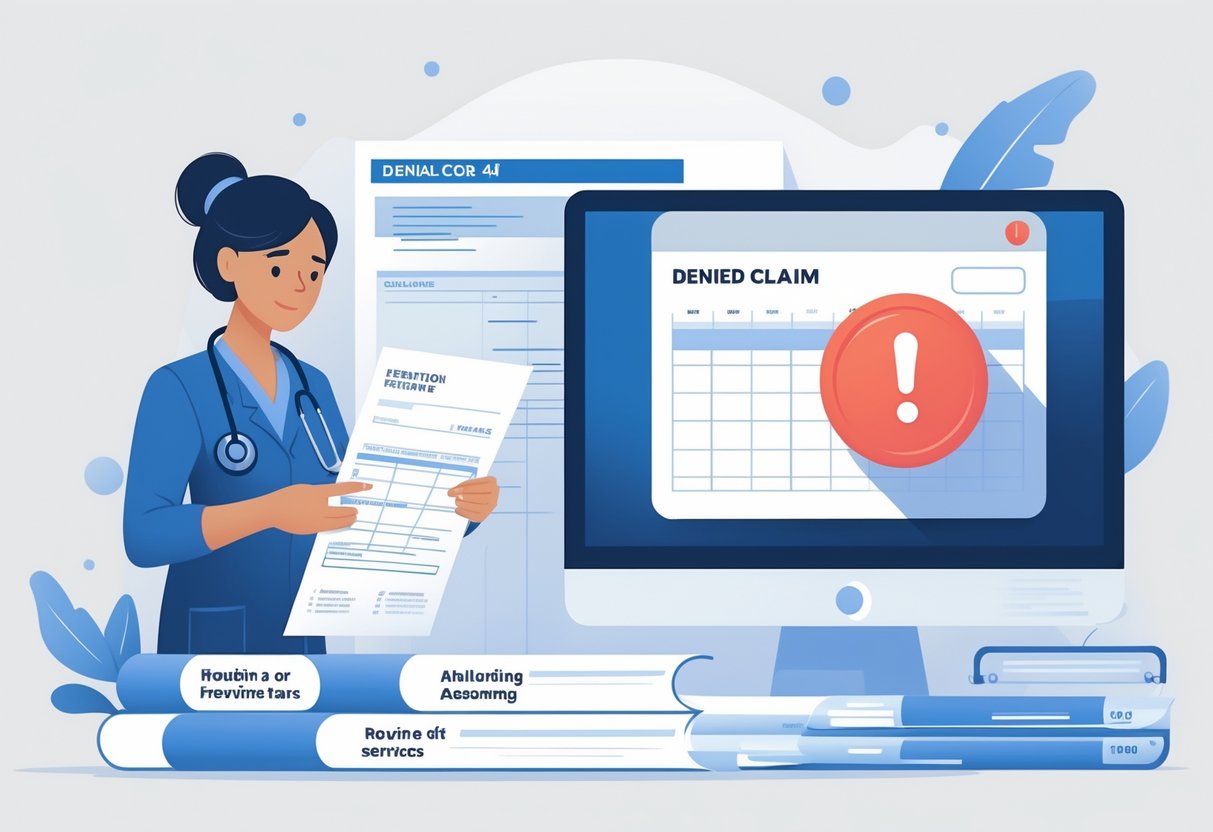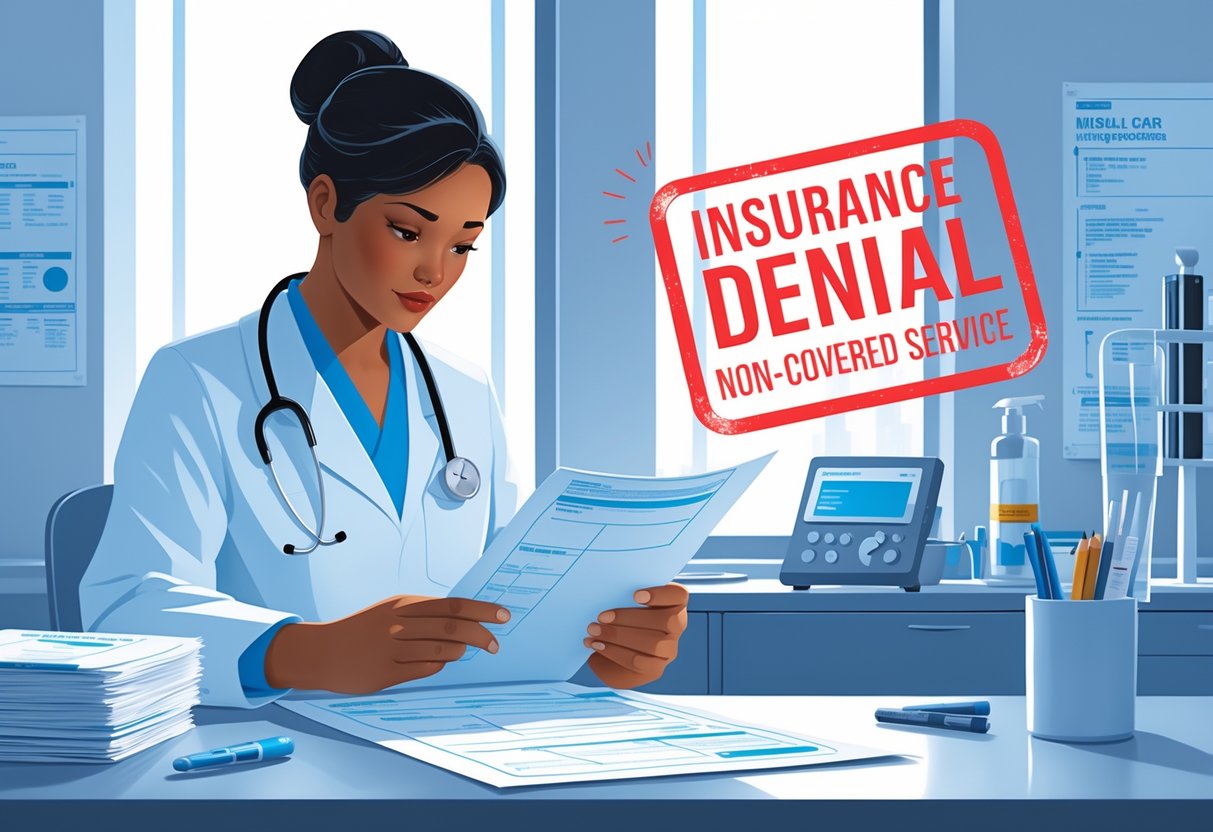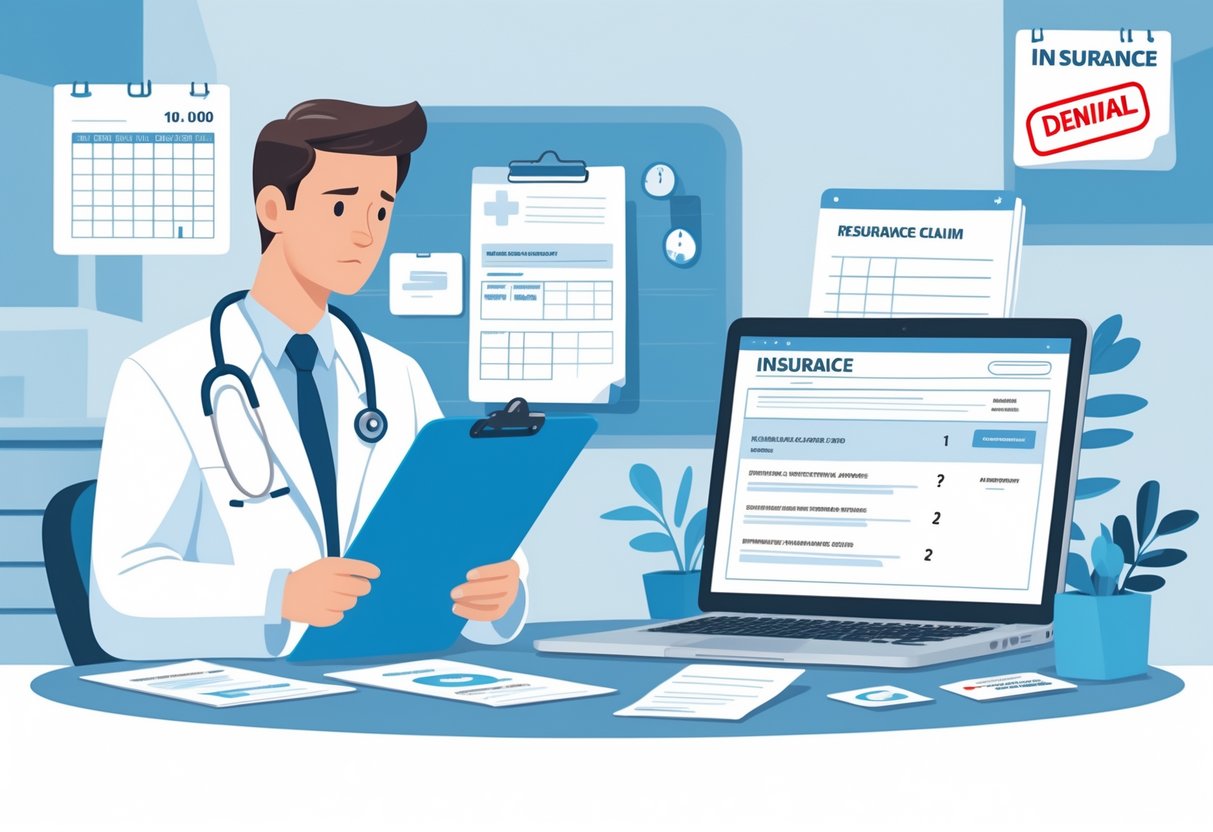If you’ve seen a denial code 49 on a medical bill or insurance claim, it usually means the service was not covered because it was seen as a routine or preventive exam. This can happen even when a diagnostic or screening procedure is done along with a routine checkup.
Denial code 49 means the insurance considers the service a routine or preventive exam, which they don’t cover separately if done with related procedures. Knowing this helps you understand why a claim might be denied and what steps to take next.
Understanding this code can save you time and confusion when dealing with insurance claims. It also helps you prepare for discussions with your doctor or insurance provider about what is covered.
Understanding Denial Code 49

Denial Code 49 means a service is not covered because it is linked to a routine or preventive exam. You need to know what this code means, how it relates to other claim adjustment reason codes, and how it differs from other denials.
Definition and Context
Denial Code 49 is used when a claim includes a service considered routine or preventive, or a diagnostic test done alongside a routine exam. This means the insurer views the service as already included in the routine exam and will not pay extra.
If you submit a claim with this code, the insurer says the service is non-covered. This is common with preventive screenings or diagnostic procedures attached to routine exams. Knowing this helps you avoid billing errors and incorrect denials.
This code is part of claim adjustment reason codes you might see on Explanation of Benefits (EOB) statements. It communicates why the claim or part of it was denied.
Related Claim Adjustment Reason Codes
Denial Code 49 often appears with other Claim Adjustment Reason Codes (CARCs). Some related CARCs include:
- CARC 97: The service is not paid separately because it is bundled.
- CARC 19: Service is denied as it is not covered.
These codes explain why your claim adjustment was made. Understanding how CARCs work alongside Denial Code 49 helps you know if you need to remove or change services on your claim.
Check your claim carefully for both Denial Code 49 and related CARCs. This helps you fix claims before resubmitting.
How Denial Code 49 Differs From Other Denials
Denial Code 49 specifically targets routine or preventive services and their related tests. Other denials might happen for different reasons like eligibility, incorrect coding, or lack of authorization.
For example, if a service is denied because it was not medically necessary, that is different from Denial Code 49. Your service here is denied because it is viewed as part of a covered routine exam, not because of medical necessity or eligibility.
Knowing this difference helps you decide if to appeal, adjust the claim, or talk to the provider about billing practices. It saves time and confusion when dealing with claim denials.
What Constitutes a Non-Covered Service

Non-covered services happen when insurance does not pay for certain routine or preventive exams and related procedures. Coverage depends on whether the service is considered medically necessary or if it is part of a routine check.
Routine/Preventive Exams
A routine or preventive exam is a checkup meant to keep you healthy rather than treat an illness. These exams include physicals, wellness visits, and basic screenings.
Insurance plans often exclude payment for these exams if they are not part of a medical need. When you get a routine exam, services done during that visit can be labeled as non-covered if they don’t meet coverage rules.
Diagnostic and Screening Procedures
Diagnostic and screening procedures test for health problems or monitor existing conditions. Screening looks for diseases before symptoms appear, like mammograms or colonoscopies.
If these procedures are done with a routine or preventive exam but are not clearly necessary, insurance may deny coverage. You must show that the procedure is more than routine to avoid being non-covered.
Routine Services and Medical Necessity
Medical necessity means the service is needed to diagnose or treat a health issue. Routine services are often not medically necessary unless linked to a specific problem.
If the service is part of a general checkup without a diagnosed issue, it may be denied as non-covered. Documentation must prove the reason why the procedure is essential.
Examples of Non-Covered Services
Common non-covered services include:
- Routine physical exams without illness
- Preventive dental cleanings beyond allowed limits
- Screening tests done without prior risk factors
- Tests repeated too soon after a previous screening
These services can trigger denial code 49 because insurance sees them as part of a routine exam, not needing coverage under your plan.
How Denial Code 49 Impacts Claims
Denial code 49 affects how your claims are reviewed and paid. Understanding the roles of procedure codes, modifiers, and coordination of benefits is important to avoid mistakes and delays.
Claim Submission and Adjudication
When you submit a claim, it must clearly show if the service is routine or diagnostic along with any related procedures. If your claim includes a routine exam and a screening done at the same time, the payer may deny the second service using denial code 49. This happens because routine exams usually do not cover extra tests unless coded or billed properly.
Claims are adjudicated based on the details you provide. Errors like missing modifiers or incorrect procedure codes often lead to denial code 49. To prevent denials, make sure each service has a clear reason supported by your documentation.
Role of Procedure Codes and Modifiers
Procedure codes tell payers what service was performed. You must choose the correct codes for routine exams and diagnostic tests. For example, using screening codes alongside routine exam codes can trigger denial code 49 if not justified.
Modifiers can change the meaning of a procedure code. When used properly, modifiers explain that a diagnostic service is separate and necessary, preventing denial code 49. Without proper modifiers, claims might be seen as duplicates or bundled, leading to denials.
Common Claim Errors
Many claims get denied with code 49 due to common mistakes. Using incorrect procedure codes or forgetting to add modifiers causes insurers to reject the secondary service. Duplicate claims for the same service in the same visit also result in denial code 49.
Failing to document the medical necessity of additional tests is a frequent problem. Your claim must clearly show why the test is not part of the routine exam. Double-check your billing to ensure no overlapping services are submitted.
Coordination of Benefits Considerations
If the patient has multiple insurance plans, coordination of benefits affects claims with denial code 49. The primary insurance may reject a preventive test as non-covered, while the secondary might pay for it.
You must submit claims to both insurers properly and report how benefits coordinate. Incorrect coordination can trigger denial code 49, especially if one plan views the service as routine while the other considers it diagnostic. Accurate records help avoid payment conflicts.
Policy Guidelines and Remittance Advice
Understanding the details in your payment advice is important when dealing with denial code 49. Knowing how coverage rules, fee schedules, and remittance codes work together helps you identify why a claim was denied and what steps to take next.
835 Healthcare Policy Identification Segment
The 835 Healthcare Policy Identification Segment tells you which insurance policy or contract applies to the claim. This segment is part of the 835 electronic remittance advice and includes policy numbers and coverage types.
You will find identifiers that show if the service is covered, partially covered, or not covered. For denial code 49, this segment confirms the service was seen as routine or preventive, excluded under the patient’s current plan. Check this segment to verify the coverage rules that led to the non-payment.
Coverage Requirements and Fee Schedules
Coverage requirements set the rules for which services are payable under a plan. In the case of denial code 49, preventive exams or diagnostic tests done alongside these exams often do not qualify for additional payment.
Fee schedules list allowed amounts for covered services. If a service is routine or preventive and bundled, it usually won’t have a separate fee. Knowing your payer’s fee schedule helps you understand why the claim was denied and if resubmission with changes is possible.
Remittance Advice Codes and Interpretation
Remittance advice includes codes that explain payment decisions. For denial code 49, you’ll see specific codes indicating the service is non-covered as part of a preventive procedure.
Look for reason codes like “N452,” which means the procedure is routine or preventive and already included in another service. Use these codes to track denials, confirm patient liability, or dispute claims when appropriate. Reading these codes carefully helps you manage reimbursements properly.
Medicare and Other Payer Considerations
You need to understand how Medicare and other payers handle routine and preventive exam denials, including specific rules for filing claims and special cases like work injuries or capitation agreements. Documentation and timing are key factors in avoiding or resolving these denials.
Medicare Coverage and the Coverage Database
Medicare generally does not cover services marked as routine or preventive exams if they are billed with a diagnostic procedure done at the same time. You should check the Medicare Coverage Database (MCD) before submitting claims to confirm which services are covered.
The MCD provides detailed notes on coverage rules, including when preventive exams become non-covered due to associated diagnostic tests. Using the MCD can help you avoid getting denial code 49 by making sure you bill services separately when possible.
Time Limit for Filing
Medicare usually requires claims to be filed within a specific time frame to be eligible for payment. You have 12 months from the date of service to submit Medicare claims for coverage.
If you miss this deadline, the claim will likely be denied regardless of the medical necessity or diagnosis. Be aware that some states or other payers might have shorter or longer limits. Always verify the time limit for each payer to avoid denials due to late filing.
Work-Related Injuries and Capitation Agreements
For work-related injuries covered by workers’ compensation or other programs, Medicare often acts as a secondary payer. You need to coordinate billing with primary payers to avoid penalties or denials like code 49.
Capitation agreements, where providers receive a fixed payment per patient, may affect how you report these exams. In those cases, Medicare might deny routine service claims if it believes the payment has already been made under the agreement. Review your contracts carefully to understand reporting requirements.
Handling Missing Documentation
Missing documentation is a common cause of denials, especially when a service overlaps routine and diagnostic categories. You must supply clear paperwork showing why each procedure was necessary and separate, if applicable.
Make sure to include referral forms, clinical notes, and test results to support your claim. If information is missing, ask the provider or patient promptly to avoid delays. Keeping thorough records helps prevent denials based on incomplete documentation.
Frequently Asked Questions
You may encounter denied claims when services are labeled as routine or preventive. Understanding which services fall under this category and how to handle denials can help you manage your medical bills better.
What services are classified as non-covered due to being deemed routine or preventive?
Services like annual physical exams, routine screenings, and basic check-ups are often non-covered if insurance views them as routine or preventive. These include procedures done just to check health without specific symptoms.
How can one appeal a denial when a service is considered routine or preventive by insurance?
You can submit an appeal with additional medical records or a doctor’s note explaining why the service was necessary. Contact your insurance provider for the exact steps and forms required to start the appeal process.
What specific procedures fall under the umbrella of diagnostic/screening procedures in conjunction with a routine/preventive exam?
Blood tests, X-rays, or imaging done alongside a routine exam can be considered diagnostic or screening procedures. If they are not directly related to a specific illness, they often get denied under this code.
In what scenarios does Medicare typically deny coverage for a procedure or service?
Medicare may deny coverage when it classifies the service as routine or preventive without clear medical necessity. It does not cover services meant only for screening unless you have symptoms or risk factors.
What does a patient need to know about CO 49 and routine/preventive services in medical billing?
CO 49 means your service was denied because it was seen as routine or preventive. You might have to pay out of pocket unless you can prove the service was medically needed.
Are there any exceptions to when a routine/preventive service might be covered despite initially receiving a denial code 49?
Yes, if your doctor shows that the service was medically necessary or linked to a health problem, insurance may cover it after review. You can provide extra documentation to support this case.







